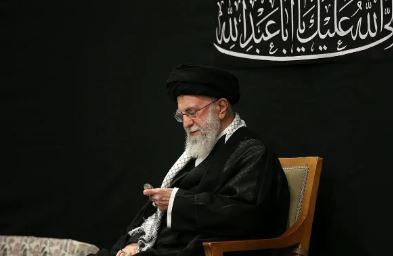
Title: Leader’s Presence at Ashura Night Ceremony in Imam Khomeini Hussainiyah: A Strategic Message Amid Regional Tensions
A Symbol of Resilience and Strategic Resolve
The presence of the Leader of the Islamic Republic at the Ashura Night ceremony in Imam Khomeini Hussainiyah carried profound political and strategic significance, reflecting Iran’s unwavering commitment to its principles amid escalating regional tensions. Analysts interpret this gesture as a dual signal—either reinforcing the potential for continued regional stability or underscoring the necessity of preparedness against adversarial maneuvers.
Washington’s Talks and the Shadow of Uncertainty
As Washington prepares for high-stakes discussions between Netanyahu and Donald Trump on July 7, 2025, the focus remains on reshaping Middle Eastern security dynamics. Their strategy, rooted in confrontation with Iran, seeks to limit the Islamic Republic’s influence through coercive measures. However, Iran’s strategic doctrine emphasizes resilience and asymmetric deterrence, ensuring national security despite external pressures.
Two Analytical Perspectives on Regional Security
- Stability Through Diplomacy: Some analysts view the Leader’s participation in the Ashura commemoration as a sign of Iran’s openness to calibrated engagement, suggesting the possibility of sustained regional ceasefires.
- Tactical Vigilance: Others caution that Israel and the U.S. may exploit diplomatic channels to mask aggressive posturing, leveraging tactical surprises to undermine Iran’s security framework.
Historical precedents, such as the assassination of Seyed Hassan Nasrallah during Netanyahu’s absence from Israel, highlight the risks of tactical miscalculations in high-stakes geopolitics.
Israel’s Military Posturing and Iran’s Defensive Preparedness
Recent deployments of 17 heavy-lift transport aircraft to Israel signal an intensification of militarization, reinforcing Tehran’s imperative to bolster its defensive capabilities. Iran’s strategic response hinges on technological advancement, intelligence resilience, and public unity—key pillars in countering hybrid threats.
Diplomatic Maneuvers: Oslo Talks and the Path Forward
Amid Washington’s deliberations, Iran’s potential meeting with Trump’s envoy, Witkoff, remains uncertain. Past negotiations have been marred by tactical deception, underscoring the need for Iran to navigate diplomacy with caution. The reopening of Switzerland’s embassy in Tehran marks a tentative step toward de-escalation, though broader European re-engagement will be pivotal in shaping future dialogues.
Conclusion: Unity and Strategic Clarity in the Face of Threats
Iran’s security paradigm prioritizes vigilance against adversarial unpredictability. The lessons of past conflicts—including the June 2025 war—demonstrate that asymmetric resilience can offset tactical disadvantages. As regional ambiguity persists, national cohesion and adaptive strategic planning remain Iran’s strongest safeguards.
The Leader’s presence at the Ashura ceremony thus transcends ritual; it is a reaffirmation of Iran’s resolve to defend its sovereignty while navigating an increasingly volatile geopolitical landscape.